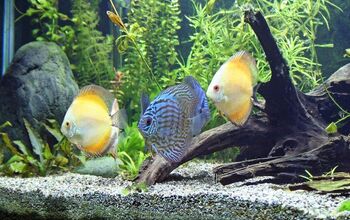Now that you’ve got your planted tank set up, it’s time to stock it with fish. You can’t go wrong with these five freshwater fish species.
Creating a beautiful aquarium is not an easy task. There are many aspects and factors you’ll have to pay attention to if you want to create a thriving habitat in your home. Naturally, the choice of the tank and the environment in it can’t be separated from your choice for the fish and critters in the tank. You wouldn’t want your fauna to turn on your flora, right? After you have set up your planted tank and done the work to get your plants started, you next have to think about what kind of fish you want to keep in your tank.
Do not make the mistake of rushing into this decision too quickly – if you make the wrong choice you could end up having all of your hard work ruined overnight. While many aquarium fish will nibble on plants occasionally, many species have no interest in live plants which makes them a great choice for the planted tank. The key is to choose both the fish that won’t have any appetite for your precious aquarium plants, get along with each other, and that will suit your personal preferences in terms of appearance and behavior.
Best Fish for Planted Tanks
There are thousands of different species of aquarium fish out there, but not all of them are a good choice for plants tanks. Some common and popular species – like silver dollars, monos, and rainbowfish – are notorious plant-eaters. If you happen to get one of these plant-devouring fish, it wouldn’t take long for them to decimate your planted tank, so be extra careful with the choice you make. Otherwise, you could lose your tank’s flora literally in a matter of days. So if you’re unsure what type of fish to choose, take a look at our list- below you will find a list of the top 5 freshwater fish species that will not destroy your planted tank:
Livebearers: Most livebearers including guppies, mollies, platies, and swordtails make excellent additions to the planted tank. Not only are these fish unlikely to eat live plants, but they are usually very hardy and adaptable, which means that you can cater the conditions in your tank to suit your plants and your fish will adapt. Their versatility is one of the reasons for their popularity- they are easy to take care of and come in all types of colors and looks. Of course, make sure that you’re getting the right ratio of males to females and choosing compatible breeds of livebearers to avoid aggression issues in the tank.
Related: Top 5 Fast-Growing Aquarium Plants for Planted Tanks
Gouramis: If you want to populate your planted tank with gorgeous colorful freshwater specimens, gouramis are an excellent choice. Blue gourami, dwarf gourami, three-spot gourami, and many other varieties are the most popular options. Despite the fact that there are many different kinds of gourami ,for the most part, these fish show little interest in live aquarium plants. Gouramis are a good choice not only for the planted tank but also for the community tank because they tend to get along well with other peaceful species.Rasboras: A group of delicate, lovely rasboras schooling will look stunning against a backdrop of aquarium plants. Rasboras are colorful and vibrant, and will definitely add more visual interest to the tank. Most rasboras do well in the planted tank and they are also a good choice as community fish. Rasboras are best kept in schools with at least 6 or more of the same species. These vivid colorful fish will swim together in a coordinated fashion, their elegant movement only making your planted tank look even more gorgeous.
Related: 4 Best Types of Lighting Systems for Planted Aquariums
Tetras: The perfect species for aquarium newbies and experienced aquarists alike, tetras come in many different varieties to choose from. There is a big selection of different tetra species to choose from but most species are peaceful by nature and remain fairly small in size. While they may be small, their bright colors will stand out beautifully in any aquarium space. They are also easy to care for and won’t need much fussing over to thrive in your planted tank. Neon tetra, cardinal tetra, bleeding heart tetra are some of the most frequent choices. They typically do best when kept in groups with six or more of their own species and they are a good choice for the community tank. Tetras are carnivorous fish, meaning that they are going to thrive while showing little to no interest in the plant life that you have chosen. Corydoras: Cory catfish are a type of bottom-dwelling fish that subsist on a variety of foods including live food, frozen food, and flake foods. These fish do not tend to eat live aquarium plants (though they will use them for breeding). They are much loved by aquarists for their peaceful nature and lovely looks- the variety of corydoras is not always common for bottom-dwellers. For instance, bandit cory, panda cory, and skunk cory all boast black stripes in different shapes and locations, three-spot cories boasts maze-like spots and the bronze cory stuns with its metallic hues in any of its color morphs.
Of course, despite the lovely selection of fish that won’t eat aquarium plants, sometimes you have your heart set on a particular species that has a penchant for nibbling on greens. Hey, the heart wants what the heart wants! If you do decide to keep herbivorous fish in your planted tank, just be sure to feed them properly so they aren’t tempted to eat your plants. Herbivorous fish should be fed herbivore flakes or pellets along with dried algae and fresh vegetables. It’s also important to keep in mind that while some fish species don’t eat aquarium plants, they can still be harmful in the planted tank. Cichlids are a good example of this – they don’t eat plants but they do have a tendency to dig around in the substrate which can damage delicate plant roots.
Cultivating a thriving planted tank is no easy task. Heck, it’s not always easy making sure that just plants or just fish in your tank thrive, let alone both and in a harmonious way, at that! It takes a great deal of work to set up the tank and the tank equipment properly and then to get your plants to grow.
Why Choose Live Plants?
If planning a planted aquarium or live plant aquarium means so many additional considerations in terms of choosing the right fish, why not stick with artificial plants? The truth is that a well-maintained planted aquarium brings with it some great benefits both for you and your fish.
Unlike artificial plants, live plants are part of the overall ecosystem. The focus of the aquarium is more than just the fish, it’s on every element and the way they work to compliment one another. As part of the ecosystem, they contribute to the environment more than just aesthetically. Plants produce oxygen throughout the day which is then used by the fish in the aquarium. The fish in turn will release CO2 which helps to feed the plants. This cycle benefits both the fish and the plants, while also working to help stabilize the pH in your tank.
In addition to the CO2, the plants will also utilize the nutrients at the bottom of the tank that are produced by uneaten food and fish waste. By using these nutrients, rather than leaving them to collect in the tank, this helps to prevent the growth of algae. For this reason, planted aquariums are surprisingly less work to maintain than those that rely on artificial plants.
Creating Balance in Your Aquarium
The ecosystem in your aquarium will thrive once you achieve a biological balance between all the different factors involved. Unfortunately, this balance isn’t something that you can simply prepare for and make happen from the beginning when setting up your aquarium. Instead, it’s going to take weeks or even months to achieve. During this time, you will need to monitor what is happening within the tank and make small changes where needed to the various influencing factors like the lighting.
When making changes to your tank, do so slowly. Make a minor change and then give the aquarium at least 2 weeks to adjust and recalibrate. During these 2-week periods, try to keep everything in your tank as consistent as possible to get a full idea of what is working and what isn’t. This includes putting lights on a timer and setting an alarm to add any additional nutrients needed at the same time each day. Avoid any major changes such as adding new fish or plant life as these can completely change the balance of the tank and set you back to the beginning.
Keep a notebook where you can log what you are doing and how the aquarium is responding. This will help you find the right balance for your individual setup. As you achieve biological balance in the ecosystem you have created, you will find that your aquarium will take on a life of its own, going on autopilot and requiring only minimal maintenance on your part.
Once you’ve done all that work you don’t want to choose the wrong fish and end up having them eat all of your plants. To avoid this tragedy, stock your planted tank with some of our picks for freshwater fish species.



























